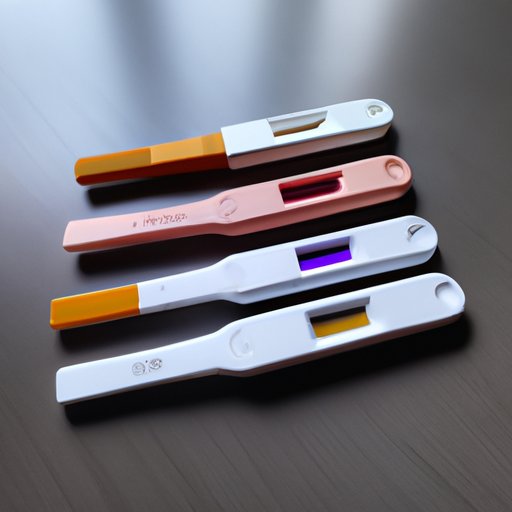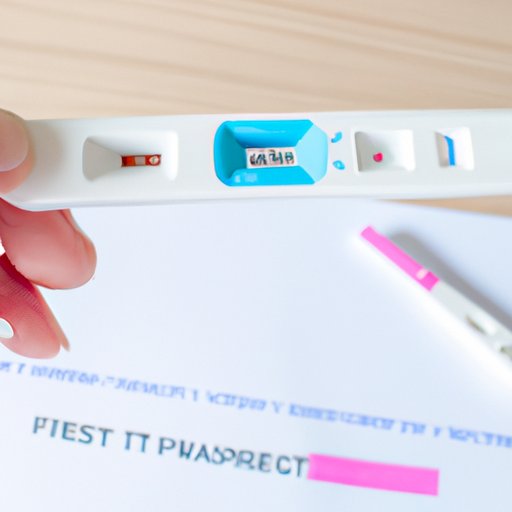Introduction
A pregnancy test is a tool used to determine whether or not someone is pregnant. It works by detecting the presence of the hormone human chorionic gonadotropin (hCG) in a person’s urine or blood. This hormone is produced during pregnancy, so its presence can be used to confirm a pregnancy.
The purpose of this article is to explore the science behind pregnancy tests and how they work. We will look at how hormone levels affect a pregnancy test, how to read and interpret the results, types of tests available, common misconceptions about the results, and potential risks associated with taking a home test.

Explaining the Science Behind a Pregnancy Test
Human chorionic gonadotropin (hCG) is a hormone that is produced during pregnancy. It is released into the bloodstream after a fertilized egg implants in the uterus. The amount of hCG in the body increases as the pregnancy progresses, reaching its peak in the first 8 to 11 weeks after conception.
Pregnancy tests work by detecting the presence of hCG in the urine or blood. If the test detects hCG, it will indicate a positive result, meaning the person is likely pregnant. If the test does not detect hCG, it will show a negative result, meaning the person is likely not pregnant.
How to Read and Interpret Pregnancy Test Results
Pregnancy tests can provide two types of results: positive or negative. A positive result means the test detected hCG, indicating a pregnancy. A negative result means the test did not detect hCG, indicating the person is likely not pregnant. It is important to note, however, that false results are possible.
False positives are rare but can occur if the test was taken too early in the pregnancy, if the test was done incorrectly, or if the test is expired. False negatives are more common and can occur if the test was taken too soon after conception, if the urine sample was too diluted, or if the person has an unusually low level of hCG.

Types of Pregnancy Tests Available
There are several different types of pregnancy tests available. Home pregnancy tests use a chemical reaction to detect hCG in a person’s urine. These tests are typically over-the-counter and are easy to use. Other types of tests are available as well, such as blood tests, which measure the exact amount of hCG present in the body.
Each type of test has its own advantages and disadvantages. Home pregnancy tests are convenient and usually less expensive than other tests, but they may not be as accurate. Blood tests are more accurate but require a visit to a doctor or lab.

Common Misconceptions about Pregnancy Tests
There are several common misconceptions about pregnancy tests. One misconception is that a false positive result means a person is actually pregnant. This is not true; a false positive simply means the test detected hCG when there was none present.
Another misconception is that a false negative result means a person is not pregnant. Again, this is not true; a false negative simply means the test did not detect hCG when there was some present.
It is also important to note that some medications, such as fertility drugs, can cause false positive results. Additionally, urine tests can give inaccurate results if the urine sample is too diluted.
Benefits and Risks of Using a Home Pregnancy Test
Home pregnancy tests have several advantages. They are convenient, easy to use, and usually less expensive than other tests. Additionally, many home tests are now capable of providing results in as little as five minutes.
However, there are also some potential risks associated with using a home pregnancy test. These tests are not always 100% accurate and can produce false results. Additionally, home tests can be difficult to interpret, especially for those who are unfamiliar with them. It is important to read the instructions carefully before taking a home test.

When to Take a Pregnancy Test
When deciding when to take a pregnancy test, there are several factors to consider. Most experts recommend waiting at least two weeks after missing a period before taking a test. This allows enough time for hCG levels to build up in the body. Additionally, it is best to take the test first thing in the morning, when hormone levels are highest.
If the test is negative but the person still suspects they might be pregnant, they should wait a few days and then retest. If the test is still negative and the person still believes they may be pregnant, they should contact their doctor for further testing.
The Impact of False Positives and Negatives from Pregnancy Tests
False positives and negatives from pregnancy tests can have both emotional and physical impacts on a person. On an emotional level, false results can be extremely stressful and can cause feelings of confusion, anxiety, and uncertainty. On a physical level, false results can lead to unnecessary changes in diet or lifestyle.
For this reason, it is important to understand the limitations of home pregnancy tests and to speak with a doctor for further testing if necessary.
Conclusion
In conclusion, pregnancy tests are tools used to determine whether or not someone is pregnant. They work by detecting the presence of the hormone hCG in a person’s urine or blood. There are several types of tests available, each with its own pros and cons. Additionally, false positives and negatives are possible, and these can have both emotional and physical impacts on a person.
It is important to understand the limitations of home pregnancy tests and to speak with a doctor for further testing if necessary. Ultimately, knowing how pregnancy tests work and how to interpret the results can help ensure accurate results and peace of mind.
(Note: Is this article not meeting your expectations? Do you have knowledge or insights to share? Unlock new opportunities and expand your reach by joining our authors team. Click Registration to join us and share your expertise with our readers.)
